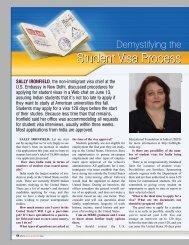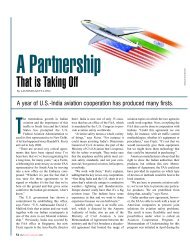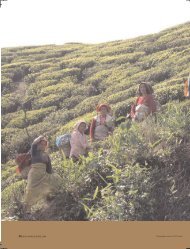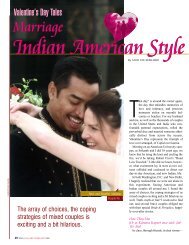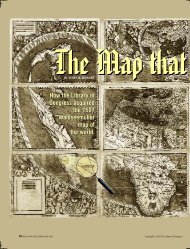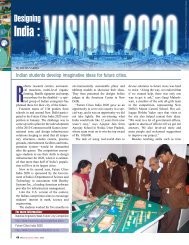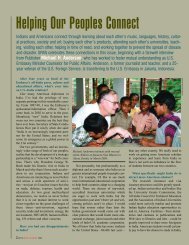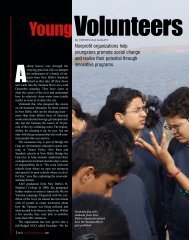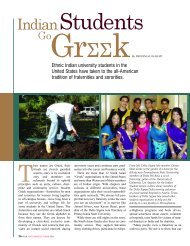Create successful ePaper yourself
Turn your PDF publications into a flip-book with our unique Google optimized e-Paper software.
LEA TERHUNE<br />
Si<br />
16 SPAN MAY/JUNE 2005<br />
hs <strong>Rule</strong> <strong>in</strong><br />
<strong>Central</strong> <strong>Valley</strong><br />
By LEA TERHUNE
When the first Sikh immigrants arrived <strong>in</strong> California’s fertile <strong>Central</strong><br />
<strong>Valley</strong> more than a century ago, they were rem<strong>in</strong>ded of the pla<strong>in</strong>s <strong>in</strong><br />
their homeland, the Punjab. Their farm<strong>in</strong>g skills, their will<strong>in</strong>gness to<br />
work, and their drive to get ahead ensured their rise <strong>in</strong> status from<br />
humble migrant laborers who picked fruit <strong>in</strong> the hot sun to significant<br />
landowners who today control much of the agriculture <strong>in</strong><br />
California. But agriculture was just the beg<strong>in</strong>n<strong>in</strong>g. Today an<br />
estimated 250,000 <strong>Sikhs</strong> live <strong>in</strong> California, and they are found <strong>in</strong> all<br />
bus<strong>in</strong>esses and professions, mak<strong>in</strong>g a major contribution to the<br />
socioeconomic fabric of the state.<br />
LEA TERHUNE<br />
Didar S<strong>in</strong>gh Ba<strong>in</strong>s’<br />
(<strong>in</strong>set) success <strong>in</strong><br />
agriculture is legendary.<br />
His great grandfather<br />
emigrated to North<br />
America <strong>in</strong> 1890,<br />
ultimately settl<strong>in</strong>g <strong>in</strong><br />
California’s <strong>Central</strong><br />
<strong>Valley</strong>.<br />
Ba<strong>in</strong>s Ranch land on the<br />
outskirts of Yuba City,<br />
California. The Buttes<br />
rise <strong>in</strong> the distance.<br />
Ba<strong>in</strong>s is a noted grower<br />
of peaches, almonds,<br />
walnuts and prunes.<br />
SPAN MAY/JUNE 2005 17
The Yuba-Sutter area is not a hot tourist spot like<br />
the w<strong>in</strong>e-produc<strong>in</strong>g counties 160 kilometers to<br />
the west, but it has some of the best agricultural<br />
land <strong>in</strong> the United States, placed between the<br />
Sierra Nevada mounta<strong>in</strong>s to the east and the<br />
Coast Range to the west. The weather is f<strong>in</strong>e.<br />
This was one reason Sikh pioneers settled here,<br />
the Ba<strong>in</strong>s among them. The Ba<strong>in</strong>s Ranch office,<br />
surrounded by orchards on the outskirts of Yuba City, is wellappo<strong>in</strong>ted<br />
but unpretentious. Trucks and tractors are parked outside<br />
near a large, alum<strong>in</strong>um-sided barn. It is the bus<strong>in</strong>ess hub of one of<br />
the largest farmers <strong>in</strong> the <strong>Central</strong> <strong>Valley</strong>, Didar S<strong>in</strong>gh Ba<strong>in</strong>s.<br />
At 66, Ba<strong>in</strong>s looks like the patriarch he is with his long, white<br />
flow<strong>in</strong>g beard and bright orange turban. His great grandfather<br />
migrated first to Canada <strong>in</strong> 1890, and to California <strong>in</strong> 1920.<br />
Ba<strong>in</strong>s’ father arrived from India <strong>in</strong> 1948 and Ba<strong>in</strong>s himself followed<br />
<strong>in</strong> 1958, 18 years old, fresh from Nangal Khurd village <strong>in</strong><br />
Hosiharpur. Those were long, hard days. “You know, we came<br />
here empty-handed, and I worked like a manual laborer,” he<br />
says. “We worked really hard, borrowed, struggled, took risks<br />
our whole life. God is always good to us.” He is known as the<br />
top peach grower, but also cultivates prunes, walnuts and<br />
almonds. “Some crops are pretty good, walnuts, almonds, still<br />
get a return. But peaches, no, because there is too much manual<br />
labor and the cost is too high.” He supplies peaches to big distributor<br />
Del Monte, but has recently dismantled one of his canneries<br />
<strong>in</strong> Yuba City.<br />
A few years ago Ba<strong>in</strong>s began sell<strong>in</strong>g parcels of land to hous<strong>in</strong>g<br />
and commercial developers. “When I saw the way that agriculture<br />
is go<strong>in</strong>g, not too much profit, then I thought I’d start to<br />
downsize.” He still owns about 6,000<br />
hectares of prime California land <strong>in</strong> the<br />
Sacramento <strong>Valley</strong> and further south,<br />
near Bakersfield, most of it near cities.<br />
He sees development as a good th<strong>in</strong>g,<br />
yet he keeps his hand <strong>in</strong> farm<strong>in</strong>g. “I love<br />
farm<strong>in</strong>g, but I like to see it make some<br />
money on the other end.”<br />
The Punjabis’ hard work and clean<br />
liv<strong>in</strong>g ga<strong>in</strong>ed their neighbors’ respect,<br />
but the earliest immigrants still faced<br />
social and economic hurdles. The same<br />
attitudes that oppressed African Americans<br />
<strong>in</strong> the South were too often<br />
applied to the turban-wear<strong>in</strong>g “H<strong>in</strong>dus”<br />
or “East Indians,” so called to dist<strong>in</strong>guish<br />
them from <strong>in</strong>digenous American<br />
Indians. They couldn’t own property<br />
and were forced to make benami-like<br />
arrangements with trusted associates to<br />
buy land. They were barred from marry<strong>in</strong>g<br />
local women, except for Mexican<br />
women, who were often immigrants<br />
themselves. Legislation eventually<br />
18 SPAN MAY/JUNE 2005<br />
resc<strong>in</strong>ded harsh anti-miscegenation laws and the Alien Land<br />
Law. Restrictive immigration quotas for South Asians were<br />
relaxed when President Lyndon B. Johnson signed the<br />
Immigration and Nationality Act of 1965. Indians could br<strong>in</strong>g<br />
their families, and immigration from all over South Asia<br />
<strong>in</strong>creased. “In the beg<strong>in</strong>n<strong>in</strong>g there was some hate,” says Didar<br />
Ba<strong>in</strong>s, “but you start a dialogue, then people start accept<strong>in</strong>g.”<br />
After more than 100 years, he says, “people are very familiar<br />
with us now. We are part of the community here. We are part of<br />
the economy here <strong>in</strong> California. We have people all the way to<br />
Los Angeles.”<br />
Newcomers also do well. Harbhajan S<strong>in</strong>gh Samra, 46, came to<br />
dom<strong>in</strong>ate okra farm<strong>in</strong>g <strong>in</strong> record time. He arrived <strong>in</strong> California<br />
with an M.A. <strong>in</strong> economics <strong>in</strong> 1985. What drew him? “Friends<br />
conv<strong>in</strong>ced me. I listened to their stories and I thought, let me<br />
make my own story.” He began supply<strong>in</strong>g produce to Indian<br />
restaurants and stores <strong>in</strong> the days when t<strong>in</strong>da, methi and moolee<br />
were hard to come by. He sold produce out of the back of his<br />
pickup truck. Later he opened a stall <strong>in</strong> the downtown Los<br />
Angeles 7th Street produce market. “You have to f<strong>in</strong>d your own<br />
niche. It’s hard <strong>in</strong> the beg<strong>in</strong>n<strong>in</strong>g to start from scratch, but once<br />
you create someth<strong>in</strong>g, you have the confidence,” he says.<br />
After 10 years of build<strong>in</strong>g his bus<strong>in</strong>ess, the next step was<br />
grow<strong>in</strong>g his own produce. His first okra crop, planted <strong>in</strong> 1994,<br />
failed. There were serious setbacks. Debts caused him to lose his<br />
farm, but he recovered. He bought several hundred acres near<br />
Indio <strong>in</strong> Southern California. Now Samra Produce & Farms,<br />
which farms about 120 hectares, has customers for Indian vegetables<br />
throughout the United States, Canada and Brita<strong>in</strong>.<br />
Accord<strong>in</strong>g to a 2001 New York Times report, Samra’s annual<br />
Pride <strong>in</strong> be<strong>in</strong>g<br />
American<br />
as well as<br />
Sikh, belief <strong>in</strong><br />
shared values.<br />
Left: A young girl <strong>in</strong> her f<strong>in</strong>ery at<br />
the annual Punjabi American Festival<br />
<strong>in</strong> Yuba City.<br />
Right: A professional dancer from Los<br />
Angeles enterta<strong>in</strong>s the crowd. Some<br />
enterta<strong>in</strong>ers are brought from India.<br />
Photographs courtesy Punjabi American Heritage Society
turnover exceeds $10 million, although he decl<strong>in</strong>es to be specific.<br />
He credits the American system for help<strong>in</strong>g him succeed.<br />
“If you are determ<strong>in</strong>ed, you can do anyth<strong>in</strong>g <strong>in</strong> the world. But<br />
<strong>in</strong> some places <strong>in</strong> the world it is rough, and <strong>in</strong> others it is<br />
smooth. In America you can do th<strong>in</strong>gs smoothly,” he says. “But<br />
you have to work for it.”<br />
Dr. Jasbir S. Kang, 42, a physician practic<strong>in</strong>g <strong>in</strong> Yuba City,<br />
comes from a long l<strong>in</strong>e of farmers, and while he is proud of his<br />
roots, he says, “We’re not just a farm<strong>in</strong>g community. There are<br />
20-plus physicians <strong>in</strong> this community. In Yuba City there is not<br />
a specialty where there is not a Sikh physician.” He enumerates<br />
the small bus<strong>in</strong>esses, gas stations, m<strong>in</strong>i-markets, restaurants and<br />
hotels where <strong>Sikhs</strong> are prosper<strong>in</strong>g. They are <strong>in</strong> construction,<br />
bank<strong>in</strong>g, eng<strong>in</strong>eer<strong>in</strong>g. “You name it, they are do<strong>in</strong>g everyth<strong>in</strong>g,”<br />
he says. Dr. Kang himself jo<strong>in</strong>ed with a number of enterpris<strong>in</strong>g<br />
physicians to purchase land and build the large medical center<br />
where he has his office.<br />
A common feel<strong>in</strong>g among <strong>Sikhs</strong> who have settled <strong>in</strong><br />
California is appreciation of America and pride <strong>in</strong> be<strong>in</strong>g<br />
American as well as Sikh. One reason for this is a belief <strong>in</strong><br />
shared values. Didar Ba<strong>in</strong>s compares the pr<strong>in</strong>ciples of the<br />
Founders, embodied <strong>in</strong> the U.S. Constitution, to those of Guru<br />
Nanak. So does Dr. Kang, who says, “The Constitution of the<br />
United States expresses the same ideals as Guru Nanak. It reads<br />
like the Guru Granth Sahib. Both advocate equality and justice<br />
for all.” Dr. Kang came to the <strong>Central</strong> <strong>Valley</strong> from Chicago <strong>in</strong><br />
1991. Hail<strong>in</strong>g from Patiala, he attended Patiala Medical College<br />
and completed his qualifications at the University of Chicago,<br />
where he came face to face with American urban realities dur<strong>in</strong>g<br />
Prom<strong>in</strong>ent American <strong>Sikhs</strong>, <strong>in</strong>clud<strong>in</strong>g several<br />
from California, were <strong>in</strong>vited to the White House on August 14,<br />
2004, to mark the 400th anniversary of the Guru Granth Sahib, celebrated<br />
on September 1, 2004. S<strong>in</strong>gh Sahib Darshan S<strong>in</strong>gh, former<br />
jathedar (priest) of Akal Takht at the Golden Temple <strong>in</strong> Amritsar,<br />
led prayers <strong>in</strong> Punjabi. Kirtans followed. Speakers <strong>in</strong>cluded Tommy<br />
G. Thompson, then U.S. Secretary of Health and Human Services,<br />
and Uttam S<strong>in</strong>gh Dhillon, Associate U.S. Attorney General, whose<br />
ancestors migrated to America a century ago. In July 2004 the<br />
Smithsonian Institution opened the Sikh Heritage Gallery, a permanent<br />
exhibition <strong>in</strong> the Natural History Museum <strong>in</strong> Wash<strong>in</strong>gton,<br />
D.C. The exhibition, entitled "<strong>Sikhs</strong>: Legacy of the Punjab," features<br />
items of Sikh heritage and culture, comb<strong>in</strong>ed with <strong>in</strong>formation<br />
on the religion and history of the Sikh people. <br />
SPAN MAY/JUNE 2005 19
his residency at Cook County Hospital. He is among the new, progressive<br />
generation who believe <strong>in</strong> rais<strong>in</strong>g community awareness<br />
about who <strong>Sikhs</strong> are. “When I came here, as a physician I had the<br />
opportunity to <strong>in</strong>teract with all k<strong>in</strong>ds of people,” he says. “I realized<br />
there was a lot of ignorance. I knew <strong>Sikhs</strong> were here for a<br />
hundred years, but still people knew very little about <strong>Sikhs</strong>.”<br />
<strong>Sikhs</strong> <strong>in</strong>teracted with their neighbors, but not <strong>in</strong> ways that conveyed<br />
much about their culture and values, “which I th<strong>in</strong>k are<br />
very much American values,” says Dr. Kang. “I felt there was a<br />
need for an organization that is dedicated to help our fellow<br />
Americans to understand us better.” He adds, “I don’t want them<br />
to see us as Indians, I want them to see us as Americans of a different<br />
shade or different flavor or whatever.”<br />
To bridge this <strong>in</strong>formation gap, Dr. Kang and other like-m<strong>in</strong>ded<br />
people formed the Punjabi American Heritage Society. In<br />
1993 they organized an event for local teachers at a Yuba City<br />
20 SPAN MAY/JUNE 2005<br />
high school. This “Teacher’s Appreciation Day,” a d<strong>in</strong>ner party<br />
that featured a slide show and Punjabi perform<strong>in</strong>g artists, was a<br />
pa<strong>in</strong>less way to better acqua<strong>in</strong>t the general community with<br />
Punjabi culture. “It was overwhelm<strong>in</strong>gly successful,” he says.<br />
They decided to organize a bigger event, and the Punjabi<br />
American Festival was born. The older generation of <strong>Sikhs</strong> had<br />
already <strong>in</strong>stituted the Sikh Parade, a religious festival started <strong>in</strong><br />
1979 and held on the first Sunday <strong>in</strong> November to commemorate<br />
Guru Nanak’s birthday. Didar Ba<strong>in</strong>s, a large donor and one of the<br />
founders, says tens of thousands come from all over the country<br />
to hear the read<strong>in</strong>g of the Guru Granth Sahib, kirtans and demonstrations<br />
of martial arts.<br />
“It’s a great event,” Dr. Kang agrees, “but sometimes people<br />
tend to treat religious events like they are just for <strong>Sikhs</strong>, although<br />
for the Sikh Parade everybody’s welcome.” The Punjabi<br />
American Festival is now an annual spr<strong>in</strong>g mela, complete with<br />
Zero Tillage <strong>in</strong> Indo-Gangetic Pla<strong>in</strong>s<br />
Eco-friendly and<br />
cost-efficient<br />
farm<strong>in</strong>g takes root<br />
Courtesy RWC<br />
Across the vast fields of India’s<br />
breadbasket, millions of farmers<br />
anxiously count the days between<br />
their wheat harvest and rice plant<strong>in</strong>g<br />
season. Too many lost days could cost<br />
a month’s earn<strong>in</strong>gs. And farmers desperate<br />
for a fast crop turnaround often end up<br />
turn<strong>in</strong>g their fields <strong>in</strong>to smoke stacks.<br />
Burn<strong>in</strong>g harvest residue is a better option<br />
for them than tak<strong>in</strong>g time to plow the land.<br />
But that’s not the right way. “This is terrible<br />
for the environment and the land, but<br />
<strong>in</strong> their m<strong>in</strong>ds, it saves them money <strong>in</strong> the<br />
short term,” says Raj Gupta, India coord<strong>in</strong>ator<br />
for Rice-Wheat Consortium for the<br />
Indo-Gangetic Pla<strong>in</strong>s (RWC).<br />
Now a major agricultural transformation<br />
is sweep<strong>in</strong>g across India’s northern<br />
rice- and wheat-grow<strong>in</strong>g belt and help<strong>in</strong>g<br />
farmers save time as well as conserve precious<br />
natural resources. The method,<br />
called “zero tillage,” utilizes a seed drill<br />
that can cut through crop residue. The<br />
seed is then dropped directly <strong>in</strong>to the soil.<br />
Farmers no longer have to engage <strong>in</strong><br />
expensive and time-consum<strong>in</strong>g plow<strong>in</strong>g.<br />
Nor do they have to resort to burn<strong>in</strong>g off<br />
harvest waste to decrease their time until<br />
A farmer <strong>in</strong> Karnal, Haryana, who has used<br />
zero tillage to plant wheat <strong>in</strong> his field.
the next plant<strong>in</strong>g. This practice saves 75<br />
percent or more on tractor fuel, obta<strong>in</strong>s<br />
better yields and requires up to 30-50 percent<br />
less water.<br />
RWC, formed <strong>in</strong> 1994, started zero-till<br />
farm<strong>in</strong>g <strong>in</strong> Pantnagar <strong>in</strong> Uttar Pradesh. In<br />
the past, the zero-till project <strong>in</strong> the Indo-<br />
Gangetic Pla<strong>in</strong>s of South Asia—cover<strong>in</strong>g<br />
Pakistan, India, Nepal and Bangladesh—<br />
has been funded by the World Bank,<br />
British Department of International<br />
Development, Directorate-General of<br />
Development Cooperation of Netherlands<br />
and the Asian Development Bank (ADB).<br />
The India office of the U.S. Agency<br />
for International Development (USAID)<br />
stepped <strong>in</strong> to fund the Indian component<br />
of the project <strong>in</strong> September 2003 when<br />
ADB fund<strong>in</strong>g came to an end, Gupta says.<br />
RWC is now one of the programs of the<br />
Consultative Group on International<br />
Agricultural Research, a global alliance<br />
that mobilizes science to benefit the poor.<br />
The concept of zero tillage was developed<br />
<strong>in</strong> the late 1950s by George E.<br />
McKibben at the Dixon Spr<strong>in</strong>gs Agricultural<br />
Center at the University of Ill<strong>in</strong>ois at<br />
Urbana-Champaign. In the 1970s James<br />
Clarke McCutcheon pioneered and popularized<br />
its use <strong>in</strong> Manitoba, Canada.<br />
Change is often viewed skeptically<br />
by traditional farm<strong>in</strong>g communities.<br />
“Farmers want to see their ga<strong>in</strong>s right<br />
away,” says Gupta. In the case of the<br />
zero-till method, farmers couldn’t help<br />
but respond to the results. Arun Bhaku, a<br />
LEA TERHUNE<br />
farmer <strong>in</strong> Uttaranchal who has been us<strong>in</strong>g<br />
zero tillage for two years to plant rice and<br />
wheat, says, “My total yield every season<br />
has <strong>in</strong>creased by at least 20 percent, and it<br />
saves me so much money. All my neighbor<strong>in</strong>g<br />
farmers have also started us<strong>in</strong>g it.”<br />
“Leav<strong>in</strong>g a protective blanket of leaves,<br />
stems and stalks from the previous crop on<br />
the surface is actually better for the longterm<br />
health of the crops and soil,” says<br />
Gupta. Residues provide a natural herbicide,<br />
reta<strong>in</strong> nutrients <strong>in</strong> soil and moderate<br />
soil temperature. “By burn<strong>in</strong>g the residue,<br />
farmers were actually stripp<strong>in</strong>g the soil of<br />
microbes and moisture that are essential to<br />
a crop’s long-term health,” he adds.<br />
Last year, zero tillage was applied to<br />
about one million hectares of farmland<br />
represent<strong>in</strong>g 10 percent of land farmed for<br />
rice and wheat and the livelihoods of<br />
10,000 farmers <strong>in</strong> the Indo-Gangetic<br />
Pla<strong>in</strong>s of India. USAID provided $1.5 million<br />
<strong>in</strong> research and development grants to<br />
engage private mach<strong>in</strong>e shops <strong>in</strong> adapt<strong>in</strong>g<br />
the seeder for different crops. The seeder<br />
has already been modified for chickpea,<br />
maize and sorghum. The special planters<br />
required for zero tillage are now be<strong>in</strong>g<br />
manufactured by about 100 companies <strong>in</strong><br />
India. In the w<strong>in</strong>ter wheat plant<strong>in</strong>g season<br />
last year, 1.7 million hectares <strong>in</strong> India<br />
were farmed us<strong>in</strong>g zero tillage.<br />
Accord<strong>in</strong>g to Gupta, farmers <strong>in</strong><br />
Haryana and Punjab save Rs. 3,000-3,500<br />
per hectare because of cost reduction <strong>in</strong><br />
tillage, fuel, labor and water and<br />
bhangra, folk dances, songs and plenty of good food. “It took off<br />
so well that right now our event is draw<strong>in</strong>g more people than the<br />
capacity of the fairgrounds.” Dr. Kang also helped start a local<br />
TV program <strong>in</strong> Punjabi called “Apna Punjab,” still runn<strong>in</strong>g after<br />
more than a decade. It provides public service <strong>in</strong>formation and a<br />
forum to discuss local issues.<br />
Then came September 11, 2001. Of that, Dr. Kang says, “I was<br />
very hurt about what had happened to our country. And then I was<br />
doubly hurt that we were blamed for someth<strong>in</strong>g we had noth<strong>in</strong>g to<br />
do with. So I felt rather than gett<strong>in</strong>g mad at other people, that, as<br />
I was an educated person of the community, it’s my obligation to<br />
help other Americans understand.” He, along with other <strong>Sikhs</strong>,<br />
wrote articles, gave speeches and sent e-mails. They raised seed<br />
Dr. J.S. Kang, a founder of the Punjabi American Heritage<br />
Society, <strong>in</strong> his Yuba City cl<strong>in</strong>ic. The sta<strong>in</strong>ed glass panel beh<strong>in</strong>d<br />
him <strong>in</strong>corporates a motif taken from the Golden Temple.<br />
enhanced wheat productivity of one to<br />
two qu<strong>in</strong>tals per hectare. For farmers <strong>in</strong><br />
eastern Uttar Pradesh, Bihar and West<br />
Bengal, the ga<strong>in</strong>s range up to Rs. 6,000<br />
per hectare because of timely plant<strong>in</strong>g.<br />
The total ga<strong>in</strong>s from this dur<strong>in</strong>g last w<strong>in</strong>ter’s<br />
wheat season were $140-180 million,<br />
accord<strong>in</strong>g to Gupta.<br />
Lat<strong>in</strong> America—where one crop with<br />
high productivity is generally harvested<br />
us<strong>in</strong>g zero tillage—has the maximum area<br />
under the system. In India, however, the<br />
technique is used for a double cropp<strong>in</strong>g<br />
system. The fact that rice is grown <strong>in</strong> wetlands—the<br />
plants are partially submerged<br />
<strong>in</strong> water—whereas wheat needs drylands<br />
was a major challenge, Gupta says.<br />
Between June and September last year<br />
northwestern India suffered drought<br />
while many parts of the east were hit by<br />
floods. Gupta says such unpredictable<br />
weather is one more reason why resourceconserv<strong>in</strong>g<br />
technologies are so important<br />
<strong>in</strong> this region. “Crops survived longer on<br />
drought-affected fields where zero tillage<br />
or m<strong>in</strong>imal tillage was used and crop<br />
residue was left on the surface. The<br />
residue also acts as good weed control,”<br />
he adds.<br />
With two-thirds of India’s one billion<br />
people depend<strong>in</strong>g on farm<strong>in</strong>g for employment,<br />
the benefits of the zero tillage<br />
techniques can be widespread. <br />
Freelance writer Ritu Upadhyay and Dipesh<br />
Satapathy contributed to this article.<br />
SPAN MAY/JUNE 2005 21
Social<br />
welfare and<br />
education<br />
rank high<br />
with <strong>Sikhs</strong>.<br />
Right: Hardeep Kaur S<strong>in</strong>gh,<br />
a real estate agent <strong>in</strong> Oroville,<br />
California, likes the life <strong>in</strong> America<br />
but wants her children to learn<br />
and preserve their Sikh heritage.<br />
She and her doctor husband are<br />
active <strong>in</strong> local community causes.<br />
Below: Young dancers at the<br />
Punjabi American Festival.<br />
money for a documentary film, Mistaken Identity: <strong>Sikhs</strong> <strong>in</strong><br />
America, that has been screened at film festivals, police departments,<br />
schools and colleges. There were no attacks on <strong>Sikhs</strong> <strong>in</strong> the<br />
Yuba City area, and Kang credits the work of the local Sikh organizations<br />
and Yuba City’s Appeal-Democrat newspaper, which<br />
aided the outreach effort by runn<strong>in</strong>g <strong>in</strong>formative articles.<br />
Social welfare and education rank high with <strong>Sikhs</strong>, whose philanthropy<br />
is not limited to the gurdwara, but extends to causes that<br />
help everyone, from aid<strong>in</strong>g rescue missions for the homeless to<br />
runn<strong>in</strong>g marathons that raise funds for the American Cancer<br />
Society. Money is sent to India as a matter of course, often to support<br />
schools or hospitals. These concerns go hand <strong>in</strong> hand with<br />
political action, second nature to the Punjabis settled <strong>in</strong><br />
California, who have been political from the earliest days. They<br />
have participated <strong>in</strong> American politics as candidates, as lobbyists<br />
and as campaign contributors. Didar Ba<strong>in</strong>s is a member of the<br />
Republican Presidential Roundtable, an elite group of bus<strong>in</strong>ess<br />
leaders who commit to give at least $5,000 annually to the party.<br />
Ironically, Dalip S<strong>in</strong>gh Saund, who became the first Asian<br />
American elected to the U.S. Congress <strong>in</strong> 1956, couldn’t get a job<br />
after tak<strong>in</strong>g his mathematics PhD at Berkeley, so he became a<br />
farmer. But times have changed, and their strong entrepreneurial<br />
spirit and savvy spells success<br />
for Punjabi Americans. They<br />
all want to own land and bus<strong>in</strong>esses,<br />
and many do. John<br />
S<strong>in</strong>gh Gill, 42, came with his<br />
parents <strong>in</strong> 1980. He grows<br />
almonds on a small farm <strong>in</strong><br />
Bakersfield; he runs a truck<strong>in</strong>g<br />
22 SPAN MAY/JUNE 2005<br />
Courtesy Punjabi American Heritage Society<br />
company, Gold L<strong>in</strong>e Express,<br />
<strong>in</strong> Woodland, whose 70 trucks<br />
serve Northern California; and<br />
LEA TERHUNE<br />
he and his brother buy and sell commercial<br />
property to developers up and down<br />
the <strong>Central</strong> <strong>Valley</strong>. They are do<strong>in</strong>g well<br />
and he has no wish to return to India. “I<br />
was 17 when I got here and it’s like<br />
home to us.”<br />
Women entrepreneurs abound. Those<br />
from big farm<strong>in</strong>g families shoulder<br />
their share of the work and explore new<br />
areas of the bus<strong>in</strong>ess, like Ba<strong>in</strong>s’ daughter<br />
Diljit. She is a real estate developer<br />
and is on the city plann<strong>in</strong>g commission.<br />
Others pursue careers <strong>in</strong> law and medic<strong>in</strong>e.<br />
Hardeep Kaur S<strong>in</strong>gh is a successful<br />
real estate agent <strong>in</strong> nearby Oroville.<br />
At her canyon-view house <strong>in</strong> between<br />
appo<strong>in</strong>tments, she expla<strong>in</strong>s that she just<br />
returned from the school, where her<br />
n<strong>in</strong>e-year-old son was show<strong>in</strong>g his hair<br />
to classmates. “Ever s<strong>in</strong>ce Gurjes has<br />
been <strong>in</strong> k<strong>in</strong>dergarten we have gone<br />
every year and he has shown his hair to the class.” With her help<br />
he shares why <strong>Sikhs</strong> keep their hair uncut. “He wants to do it,”<br />
S<strong>in</strong>gh says. S<strong>in</strong>gh and her doctor husband are active <strong>in</strong> the<br />
Punjabi American Heritage Society and other community organizations,<br />
and do their part <strong>in</strong> outreach. “We want to portray the<br />
similarities rather than the differences,” she says. She came to<br />
America with her parents when she was seven. Her father was<br />
born <strong>in</strong> Dosanj, <strong>in</strong> Moga, Punjab. She values her Sikh heritage<br />
and she wants her three children to master Punjabi. “You can<br />
speak or talk, but if you can’t read, how are you go<strong>in</strong>g to read<br />
gurbani?” Mothers have been tutor<strong>in</strong>g the kids, and a new gurdwara<br />
preschool will help answer this need.<br />
Harj Mahil’s boutique, Indian Fusion, fronts the revitalized<br />
ma<strong>in</strong> street of Yuba City’s old downtown. Festooned with saris<br />
and lehengas from floor to ceil<strong>in</strong>g, it offers a bright splash of<br />
color to passersby. Mahil says, “I opened this shop because I<br />
wanted to create a fusion of design that could be appreciated by<br />
people of Indian and non-Indian heritage alike.” Her non-<br />
Indian friend Lynn chimes <strong>in</strong>, f<strong>in</strong>ger<strong>in</strong>g an embroidered silk<br />
dupatta, “I just love it. The work is so beautiful!” She wants to<br />
visit India.<br />
Fusion may well be the byword for the active, communitym<strong>in</strong>ded<br />
<strong>Sikhs</strong> of the <strong>Central</strong> <strong>Valley</strong>. And while many families<br />
weathered hard times, their good humored resiliency and balanced<br />
view of the world have ga<strong>in</strong>ed them not only acceptance<br />
but extraord<strong>in</strong>ary success. The “okra k<strong>in</strong>g” Harbhajan Samra<br />
puts it simply: “If you don’t have guts you don’t get anyth<strong>in</strong>g<br />
done. If you have guts, you can get it done.” Undeniably, this<br />
Punjabi masala br<strong>in</strong>gs a welcome piquancy to the American<br />
melt<strong>in</strong>g pot. <br />
About the Author: Lea Terhune is a freelance writer based <strong>in</strong><br />
California, and a former editor of SPAN.




